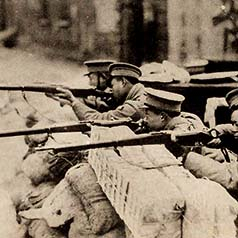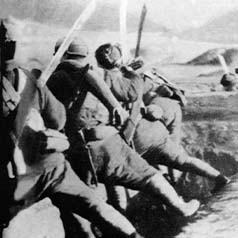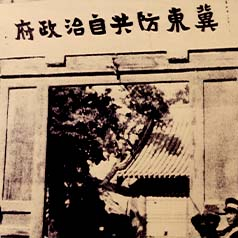
From the September 18th Incident to the Eve of the Total War of Resistance Against Japanese Aggression (1931-1937)
From the September 18th Incident to the Eve of the Total War of Resistance Against Japanese Aggression: an Overview
After the Northern Expedition reunified China in general, Japan accelerated its aggressive deployment by instigating the September 18th Incident and the January 28th Incident to advance on Northeast China and Shanghai respectively. It even set up puppet regimes in Northeast and North China. With Japan’s gradual invasion, Chinese people’s dissatisfaction with the Nationalist Government’s policy of “first internal pacification, then external resistance” grew, which finally triggered the Xi’an Incident.
From the September 18th Incident to the Eve of the Total War of Resistance Against Japanese Aggression: an Overview
After the Northern Expedition reunified China in general, Japan accelerated its aggressive deployment by instigating the September 18th Incident and the January 28th Incident to advance on Northeast China and Shanghai respectively. It even set up puppet regimes in Northeast and North China. With Japan’s gradual invasion, Chinese people’s dissatisfaction with the Nationalist Government’s policy of “first internal pacification, then external resistance” grew, which finally triggered the Xi’an Incident.
(1) The September 18th Incident and the Japanese Occupation of Northeast China
On 18 September 1931, Japan instigated the September 18th Incident and occupied Northeast China swiftly.
(2) The Establishment of the Puppet State of Manchukuo
After the September 18th Incident, Japan established the puppet state of Manchukuo in the three provinces in Northeast China it occupied and installed Puyi, the last emperor of the Qing dynasty, as the puppet ruler.
(3) The January 28th Incident
On the night of 28 January 1932, the Japanese army raided the Chinese army in Zhabei District of Shanghai. The National Revolutionary Army rose to resist the assault, which resulted in the Battle of January 28th.
(4) The Defence of the Great Wall
From March to May 1933, the Chinese army and civilians fought bloody battles against the Japanese army along the Great Wall in North China.
(5) From Tanggu Truce to He-Umezu Agreement
After the Defence of the Great Wall, China and Japan concluded the Tanggu Truce and the He-Umezu Agreement, which were conducive to Japan’s future operations in North China.
(6) The East Hebei Incident and the North China Autonomous Movement
In the mid-1930s, Japan actively established puppet regimes under its control in North China. To this end, it launched the East Hebei Incident and the North China Autonomous Movement in quick succession. Around the time of the July 7th Incident, Japan accelerated the establishment of puppet regimes in North China.
(7) The Policy of First Internal Pacification, Then External Resistance and the December 9th Movement
In the face of Japan’s invasion, the Nationalist Government of the Republic of China adopted the policy of “first internal pacification, then external resistance”, which drew broad opposition nationwide. Waves of civil movements were staged to advocate an end to the civil war and the launch of united resistance against Japan.
(8) The Xi’an Incident
On 12 December 1936, Zhang Xueliang and Yang Hucheng detained Chiang Kai-shek to force him to put an end to the civil war and launch united resistance against Japan. This became known as the Xi’an Incident.











